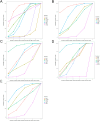Comparison of the efficacy and safety of different growth factors in the treatment of diabetic foot ulcers: an updated network meta-analysis
- PMID: 40636711
- PMCID: PMC12237656
- DOI: 10.3389/fendo.2025.1614597
Comparison of the efficacy and safety of different growth factors in the treatment of diabetic foot ulcers: an updated network meta-analysis
Abstract
Objective: This study aimed to evaluate the efficacy and safety of different growth factors (GFs) in the treatment of diabetic foot ulcers (DFUs) through a network meta-analysis.
Methods: A systematic search was conducted in PubMed, Embase, The Cochrane Library, and Web of Science to identify randomized controlled trials (RCTs) comparing GFs with standard of care (SOC) or comparing different GFs for the treatment of DFU. Two independent reviewers screened the studies, extracted data, and assessed the quality of the included literature according to predefined inclusion and exclusion criteria. A network meta-analysis was performed using R software. Relative risk (RR) was used as the effect measure for dichotomous outcomes, and mean difference (MD) was used for continuous outcomes.
Results: A total of 51 RCTs, involving 3,401 patients with DFUs and six different types of GFs, were included. The network meta-analysis revealed that, compared with SOC, epidermal growth factor (EGF), platelet-derived growth factor (PDGF), and platelet-rich plasma (PRP) significantly improved the healing rate. EGF and PRP also significantly reduced healing time, while PDGF significantly reduced ulcer area. Moreover, PRP was associated with a significant reduction in the incidence of adverse events (AEs) and amputation rates. In terms of ranking: For healing rate, the top three GFs were EGF, vascular endothelial growth factor (VEGF), and granulocyte colony-stimulating factor (G-CSF). For healing time, EGF, PRP, and fibroblast growth factor (FGF) ranked the highest. For ulcer area reduction, PDGF, EGF, and PRP were the top-ranking interventions. Regarding AEs, PRP, PDGF, and FGF showed the most favorable safety profiles. For amputation rate, PRP, G-CSF, and PDGF were ranked the highest.
Conclusion: Almost all GFs outperformed SOC in terms of healing rate, healing time, and ulcer area reduction. Compared to SOC, EGF, PDGF, and PRP significantly improved healing rates; EGF and PRP significantly reduced healing time; and PDGF significantly decreased ulcer area. Among them, EGF may be the most effective GF. Except for VEGF, which significantly increased AEs, other GFs did not show a significant increase in AEs compared to SOC. PRP had the lowest amputation rate and incidence of AEs.
Systematic review registration: https://www.crd.york.ac.uk/prospero/, identifier CRD420251035765.
Keywords: diabetic foot ulcer; growth factors; network meta-analysis; randomized controlled trial; standard of care.
Copyright © 2025 Tian, Yao, Tian, Li, Li, Wu and Zhang.
Conflict of interest statement
The authors declare that the research was conducted in the absence of any commercial or financial relationships that could be construed as a potential conflict of interest.
Figures




Similar articles
-
Comparison of the efficacy of 12 interventions in the treatment of diabetic foot ulcers: a network meta-analysis.PeerJ. 2025 Aug 11;13:e19809. doi: 10.7717/peerj.19809. eCollection 2025. PeerJ. 2025. PMID: 40821981 Free PMC article.
-
Effectiveness of most common adjuvant wound treatments (skin substitutes, negative pressure wound therapy, hyperbaric oxygen therapy, platelet-rich plasma/fibrin, and growth factors) for the management of hard-to-heal diabetic foot ulcers: a meta-analysis of randomized controlled trials for the development of the Italian Guidelines for the Treatment of Diabetic Foot Syndrome.Acta Diabetol. 2025 Jul;62(7):1081-1095. doi: 10.1007/s00592-024-02426-7. Epub 2024 Dec 26. Acta Diabetol. 2025. PMID: 39724338
-
Growth factors for treating diabetic foot ulcers.Cochrane Database Syst Rev. 2015 Oct 28;2015(10):CD008548. doi: 10.1002/14651858.CD008548.pub2. Cochrane Database Syst Rev. 2015. PMID: 26509249 Free PMC article.
-
Improving Diabetic Wound-Healing Outcomes With Topical Growth Factor Therapies.J Clin Endocrinol Metab. 2024 Jul 12;109(8):e1642-e1651. doi: 10.1210/clinem/dgae128. J Clin Endocrinol Metab. 2024. PMID: 38477463
-
Topical antimicrobial agents for treating foot ulcers in people with diabetes.Cochrane Database Syst Rev. 2017 Jun 14;6(6):CD011038. doi: 10.1002/14651858.CD011038.pub2. Cochrane Database Syst Rev. 2017. PMID: 28613416 Free PMC article.
Cited by
-
Recent Advances in the Role of Fibroblast Growth Factors in Hair Follicle Growth.Biomolecules. 2025 Aug 20;15(8):1198. doi: 10.3390/biom15081198. Biomolecules. 2025. PMID: 40867641 Free PMC article. Review.
References
-
- Ong KL, Stafford LK, McLaughlin SA, Boyko EJ, Vollset SE, Smith AE, et al. Global, regional, and national burden of diabetes from 1990 to 2021, with projections of prevalence to 2050: A systematic analysis for the Global Burden of Disease Study 2021. Lancet. (2023) 402:203–34. doi: 10.1016/S0140-6736(23)01301-6 - DOI - PMC - PubMed
Publication types
MeSH terms
Substances
LinkOut - more resources
Full Text Sources
Medical
Research Materials

